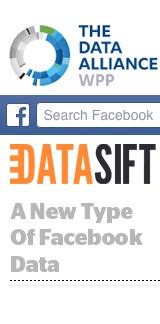 A truck manufacturer recently discovered it had an untapped market: women in the Midwest who loved to drive and own trucks.
A truck manufacturer recently discovered it had an untapped market: women in the Midwest who loved to drive and own trucks.
The source of that data wasn’t a focus group but rather Facebook topic data, a PII-free way to deliver what people are talking about on Facebook to the brands that care about it.
An early and enthusiastic adopter of Facebook topic data has been the WPP Data Alliance, an agency group created in 2011 to bring in different data sources from places like SAP, Factual, Twitter and Facebook and to facilitate their use.
Two years ago WPP Data Alliance became one of the pilot partners of DataSift. The company collects and standardizes social media data from sources like YouTube, Tumblr, Instagram, WordPress, forums and message boards (and Twitter, but you have to go through Gnip first).
When DataSift became the first outside vendor to receive access to Facebook data via Facebook topic data in March, WPP Data Alliance started using that too, helping clients like that truck company make decisions by collecting and analyzing data on behalf of clients.
Anas Ghazi, the director of global partnerships for the WPP Data Alliance, sees a place for data at all of WPP’s agencies, whether they focus on creative, media, PR or strategy. The insight about the car manufacturer’s audience came from its PR agency, he said.
“There’s the data used to evaluate the reach and efficacy of a campaign, like CTRs and brand lift,” Ghazi said. “Then there are the data signals that are broader and more difficult to capture. They can shape the direction or timing of a campaign, or give brands an idea of a new target audience.”
DataSift CEO Tim Barker said the point is to bring data to more of the decisions CMOs have to make. The company does this in part by making the process easier and cheaper than traditional data-collection methods like focus groups.
“What you learn from the audience in Facebook can be applied to any part of the marketing life cycle,” Barker said
Often, that Facebook data informs the timing of campaigns, as well as the placement and targeting of ad creative.
Facebook data helped an ad agency with a CPG client understand when people were actually eating their potato chips.
AdExchanger Daily
Get our editors’ roundup delivered to your inbox every weekday.
Daily Roundup
“Because CPGs aren’t selling direct to consumers, they don’t have loads of said about who is eating the product and where it’s being consumed,” Barker said. “They did focus groups and surveys, but behavior is really hard to do in traditional focus group research.”
The chips were being advertised around a sporting event, so the agency wanted to figure out how people were consuming chips around that event. It collected 180,000 interactions and discovered its most engaged segment on social wasn’t 18- to 24-year-old men as it had previously thought, but 35- to 64-year-old women, who talked about the snacks on Facebook six hours before the game.
Using that information, the ad agency completely re-thought what its ad creative should look like and the target audience for those ads, Barker explained. It also shifted its budget earlier in the day before the game.
DataSift’s analysis has its limits.
For the chips brand, it can’t measure what impact those changes made – except in a broader, aggregated manner. Facebook topic data isn’t about quantifying the impact of seeing an ad or attributing back to a sale. For that, brands can run ad campaigns on Facebook and use its conversion attribution tools. Or they can combine their other digital media buys with standalone measurement tools. The point here is insights.
As DataSift works to increase the use of Facebook data, WPP Data Alliance has slightly different goals. Ghazi’s big task this year is to look beyond established markets like North America and Europe and move to collecting and using data in emerging markets like Africa, India and Asia.
“We need to have the same kind of data equity in the emerging markets,” Ghazi said.













